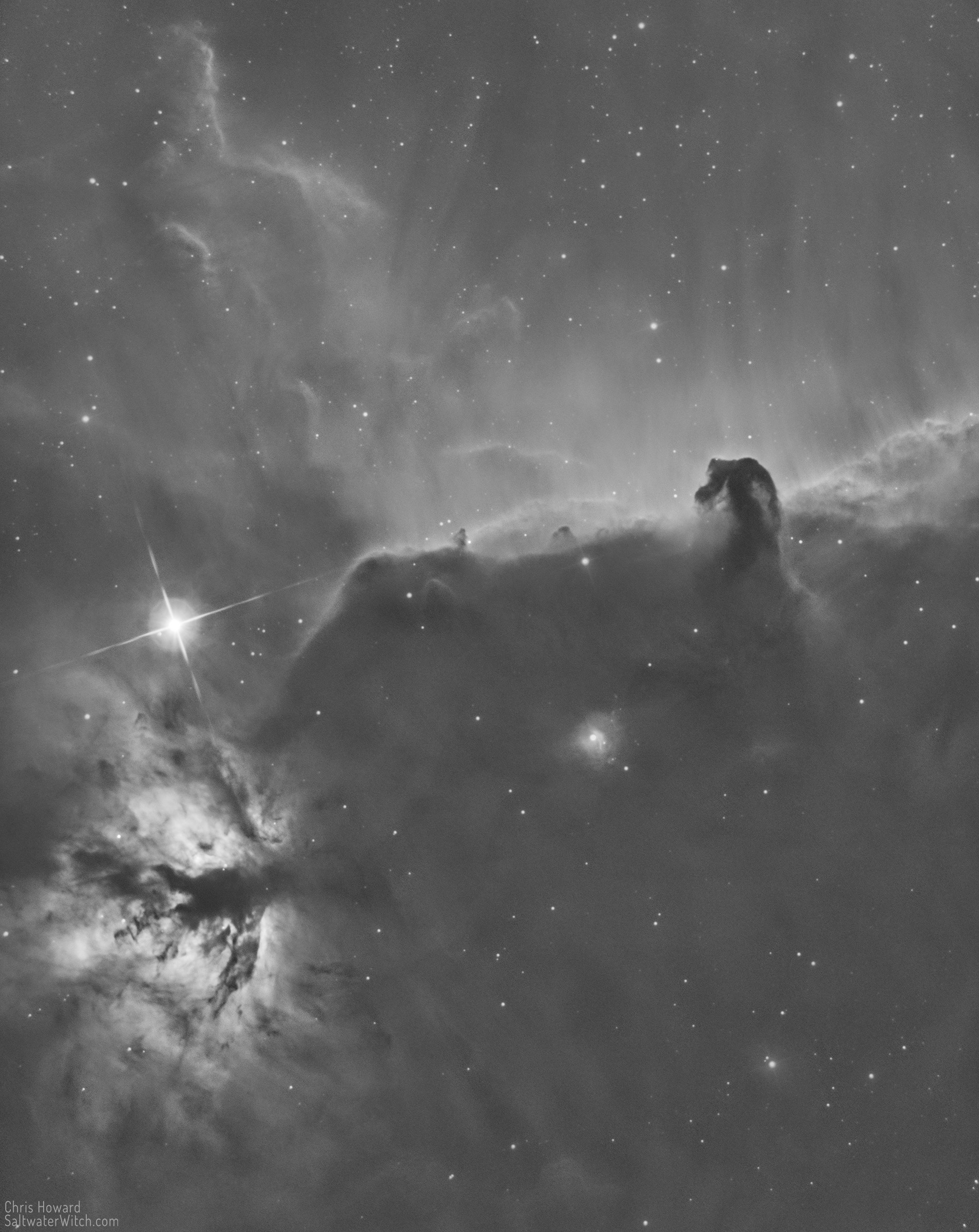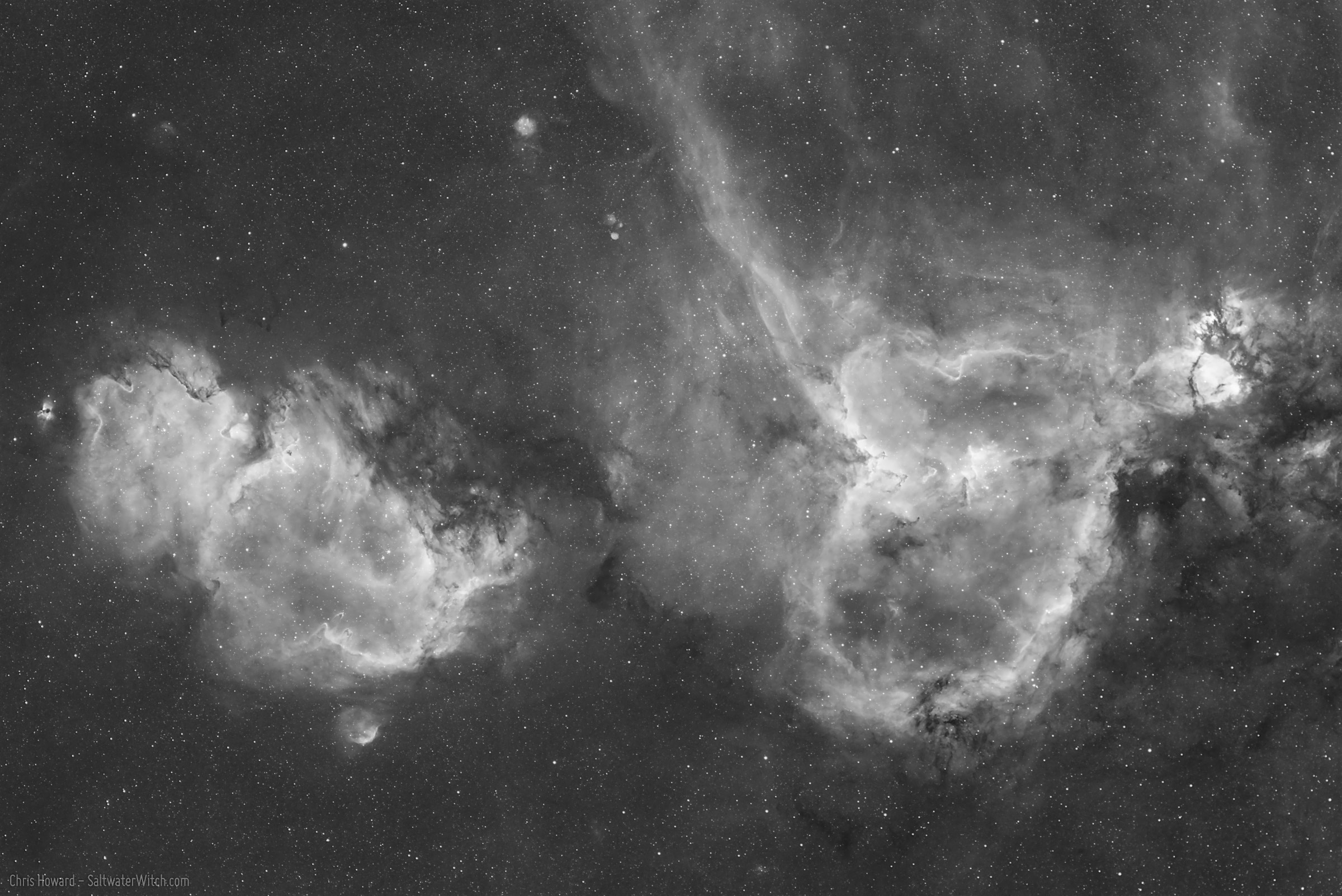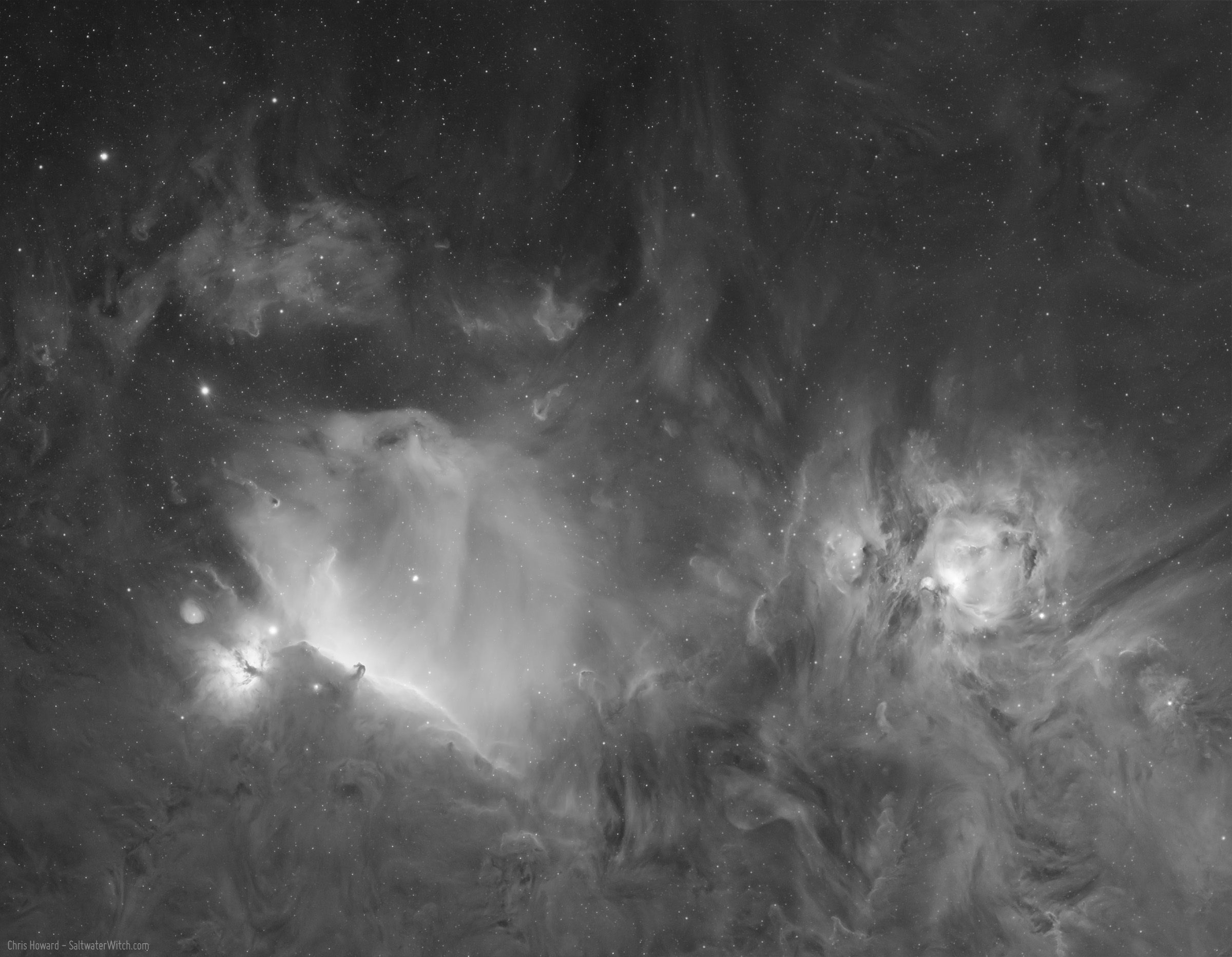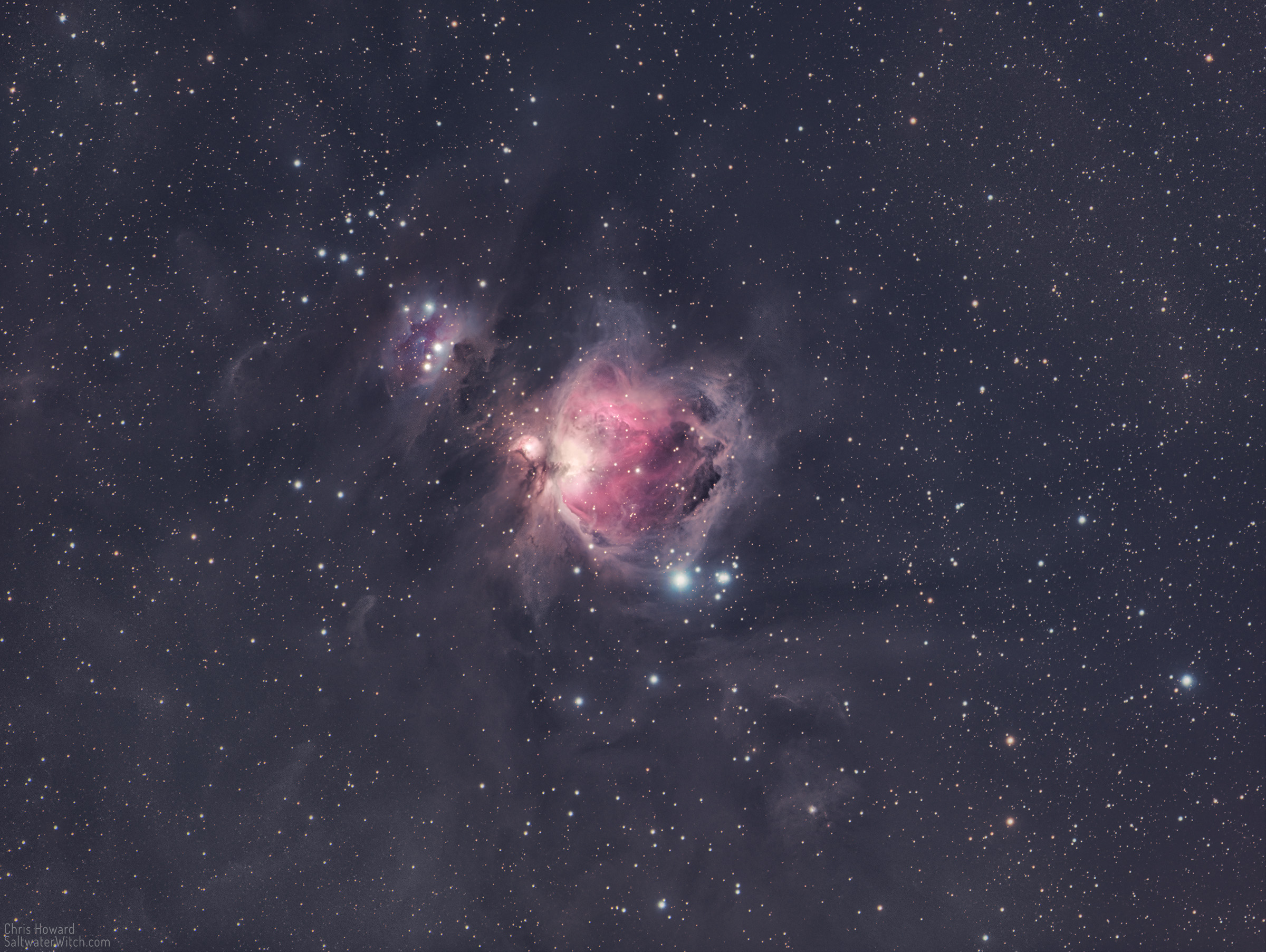M78, LDN 1622, and a piece of Barnard's Loop
Top right is a structure composed of a batch of dark nebulae clustered around the reflection nebula Messier 78 (M78, NGC 2068), about 1,350 lightyears away, and bottom left is LDN1622, the "Boogeyman Nebula" about 500 lightyears away. And the wide ribbon running between them, mostly ionized hydrogen and interstellar dust, is part of "Barnard's Loop", which runs around the Alnitak side of the constellation Orion.
Imaging Notes: 49 x 300-second subs taken with the ZWO ASI071MC color camera (cooled to 0°C, gain 0) and the William Optics Redcat 51 apochromatic refractor (250mm FL, f/4.9), Sky-Watcher EQ6-R Pro mount, ZWO ASIAir Plus astro controller. I shot 94 sub-expsures at 5-minutes each, starting around 7pm and running through the night to about 4am, but ended up tossing almost half of them, stacking the best 49.
Posted December 20, 2023
M42 Test with the new RedCat 51 and the ASI071 color camera
Well, that worked pretty well for an 88% waxing moon with the ZWO ASI071MC color camera. The near-full moon and Jupiter at opposition were just far enough away to make this set up work--plus a lot of 5-minute exposures. That band of red at the top left is the tail end of the ridge of hydrogen that runs behind the Horsehead Nebula (B33). Imaging notes: 63 x 300-second subs, no filters with the ZWO ASI071 color camera cooled to 0C, William Optics RedCat 51 Apo refractor, Sky-Watcher EQ6-R Pro mount. The Orion Nebula (M42), Running Man Nebula (Sh2-279), De Mairan's Nebula (NGC 1982,M43), and surrounding nebulosity.
Posted November 24, 2023
Imaging Session 2023-11-16
The Heart Nebula on the right (IC 1805, Sharpless 2-190) and Soul Nebula, left, (Westerhout 5 with the star cluster IC 1848) in Hydrogen-alpha. These two make up a massive star-forming complex in Cassiopeia about 7500 lightyears away in the Perseus Arm of our Galaxy. The bright emission nebula on the far right is the Fishhead Nebula (NGC 896, IC 1795). The small circular cloud, middle top, is another emission nebula Sh2-198, much further away, around 18,000 lightyears (still, well within the galaxy). The bright cluster of stars in the core of the Heart Nebula is Melotte 15.
Imaging Notes: 51 x 5-minute exposures stacked in PI, ZWO ASI2600MM-Pro monochrome camera cooled to -10C, 3nm Antlia Pro Hydrogen-alpha filter, William Optics SpaceCat 51 apo refractor, Sky-Watcher EQ6-R Pro mount. Shot from my backyard in coastal New Hampshire, bortle 4-ish.
Orion Core: two-panel mosaic of Orion's Belt, the Horsehead Nebula, and M42, the Orion Nebula.
Posted November 17, 2023
Astro Session 2023-11-11
Orion’s Belt or the Three Sisters: next time you see that familiar line of three bright stars, the “Orion’s Belt” asterism at the center of the constellation Orion, imagine the backdrop of ionized hydrogen and all the other surrounding stuff you can’t see with your eyes, the bright nebulae, the dark structures of dust and molecular gasses, vast stellar nurseries with violent new stars forming out of trillions of kilometers of hydrogen clouds. There’s so much going on behind these three stars. The center of the Belt, Alnilam, is a single massive star, a supergiant that’s 375,000 times brighter than our star. Alnitak is a triple star system, and Mintaka is a binary star, with the two stars orbiting each other every 5.7 days.
Imaging Notes: 60 x 5-minute exposures stacked in PI, ZWO ASI2600MM-Pro monochrome camera cooled to -10C, 3nm Antlia Pro Hydrogen-alpha filter, William Optics SpaceCat 51 apo refractor, Sky-Watcher EQ6-R Pro mount. Shot from my backyard in coastal New Hampshire, bortle 4-ish.
Our giant neighboring galaxy, Andromeda (M31) in HaRGB. I captured this data last night, waiting for Orion to rise above 30°. Imaging Notes: 30 x 120-second subs in RGB, 30 x 180-second subs in Ha stacked in PI, ZWO ASI2600MM-Pro monochrome camera cooled to -10C, Antlia Pro filters, William Optics SpaceCat 51 apo refractor, Sky-Watcher EQ6-R Pro mount. Shot from my backyard in coastal New Hampshire, bortle 4-ish.
Posted November 12, 2023
Narrowband Boogeyman in Orion
Sure, we're a few days late for halloween, but check out the creepiness of the dark molecular cloud LDN1622, the "Boogeyman Nebula" about 500 lightyears away in the constellation Orion, along with a bright lumpy backdrop of nebulosity lit from above by the variable star 56 Orionis. LDN1621 is the dark nebula to the left of the Boogeyman, and the reflection nebula VdB 62 is just to the right. The uneven cloudiness at the top right is a small section of Barnard's Loop (Sh2-276), which may give you an indication of LDN1622's location, on the other side of the Loop from M78, about halfway up one side of Orion. Notes: 36 x 8-minute exposures, almost five hours of data in hydrogen-alpha (Antlia 3nm Ha Pro filter), William Optics GT81 Apochromatic refractor 382mm FL at f/4.7, ZWO ASI1600MM-Pro mono camera cooled to -10C.

Posted November 4, 2022
M42 up close in Ha
The Orion, De Mairin and Running Man Nebulas (M42, M43, NGC 1977) in narrowband hydrogen-alpha. 36 x 300-second exposures, Newtonian 800mm @ f/4.

Posted October 22, 2022
Narrowband with the Newt
We finally had some clear-ish skies last night after several days of gloom and rain, and I got to test out the 800mm f/4 newtonian scope with the ZWO ASI1600MM-Pro monochrome camera and 3nm narrowband filters. I spent most of the night imaging NGC 6888, the Crescent Nebula in Ha and OIII, and around 2am moved to the other side of the sky (away from a ~30% waning moon) to capture the Horsehead Nebula (B33) and the Flame Nebula (NGC 2024, Sh2-277), along with the leftmost star in Orion's Belt, Alnitak (bright star with the diffraction spikes from the Newtonian's secondary mirror) Alnitak is actually a triple star system, with most of the light and energy coming from ζ Orionis (zeta Ori), a massive blue super-giant 20 times larger than our star and over 21,000 times brighter. Imaging notes: 20 x 300-second subs in Ha, stacked in DSS. Apertura 800mm f/4 Newtonian OTA, ZWO ASI1600MM-Pro mono camera, Antlia 3nm Ha filter, ZWO ASI290M OAG, on the Sky-Watcher EQ6R-Pro mount with the ZWO ASIAir Plus controller.

NGC 6888, the Crescent Nebula in Ha+OIII. The Crescent is an emission nebula 25 lightyears across, about 5000 lightyears away in the constellation Cygnus. This interesting set of structures with multiple shock waves, including an inner shell of hydrogen surrounded by an expanding envelope of oxygen (the semi-transparent bubbling blue structure) is the result of a collision of the fast-burning Wolf-Rayet star WR136 with a massive red-giant star. I usually shoot the Crescent in hydrogen-alpha only, and that will only pick up that inner crusty blob, but it's way creepier with the oxygen bandpass data and that weird semi-transparent blue sleeve, perfect for October. Imaging notes: 80 x 300-second subs in Ha and OIII, stacked in DSS. Apertura 800mm f/4 Newtonian OTA, ZWO ASI1600MM-Pro mono camera, Antlia 3nm Ha, OIII filters, ZWO ASI290M OAG, on the Sky-Watcher EQ6R-Pro mount with the ZWO ASIAir Plus controller.

Posted October 19, 2022
Orion Nebula in RGB
It's that time of year—my favorite, in fact. The autumnal equinox was on the 22nd, and that means Orion is back in the night sky, well actually in the very early morning sky. Last night the whole constellation was above the trees, around 25° rising in the East at 2 AM, and I captured 30 subs each for Red, Green, Blue, Luminance. Here they are stacked and processed.







